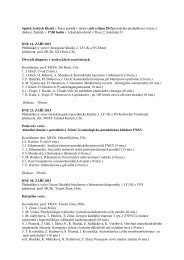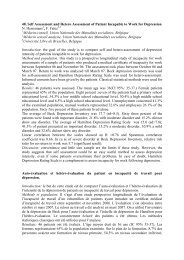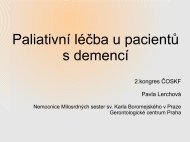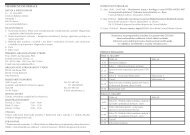ABSTRACTS â ORAL PRESENTATIONS - AMCA, spol. s r.o.
ABSTRACTS â ORAL PRESENTATIONS - AMCA, spol. s r.o.
ABSTRACTS â ORAL PRESENTATIONS - AMCA, spol. s r.o.
You also want an ePaper? Increase the reach of your titles
YUMPU automatically turns print PDFs into web optimized ePapers that Google loves.
technological properties PHB is considered as an alternative to petrochemical polymers<br />
such as polyethylene or polypropylene. Moreover, unlike synthetic polymers, PHB can<br />
be produced from renewable or waste substrates and it is also fully biodegradable and<br />
biocompatible (Kessler and Wilholt 2001).<br />
Analysis of intracellular PHB content of the bacterial cells is an important challenge<br />
connected with biotechnological production of PHB. The most common technique to<br />
quantify PHB is based on Gas Chromatography (GC), however, this method does not<br />
provide rapid tool to analyze PHB content of cells in bioreactor due to labor intensive and<br />
time-consuming sample preparation. From this point of view, flow cytometry analysis of<br />
Nile Red stained cells seems to be superior to GC due to its simplicity and rapidity (Vidal-<br />
Mas et al. 2001).<br />
The aim of this work was to develop method for analysis of intracellular PHB content<br />
by using Nile Red staining and Flow Cytometry. Cupriavidus necator H16 (formerly<br />
Alcaligenes eutrophus, Wautersia eutropha and Ralstonia eutropha) was cultivated in<br />
5 l bioreactor (Biostat B plus, Sartorius Biotech, Germany) using mineral salt medium<br />
and waste frying oil as a carbon source (Obruca et al. 2010). Samples were withdrawn at<br />
regular intervals; cells were pelleted, washed with PBS buffer and fixed with cold ethanol<br />
(30%, 15 min). After that, the cell suspension (1 ml, approx. 10 6 of cells/ml) was stained<br />
with 1 ml of Nile Red (1 mg/ml of DMSO). Analysis of cell population was performed<br />
using Apoggee A50 (Apogee, GB) (excitation at 488 nm, emission was analyzed using<br />
orange channel). PHB none-producing mutant strain Cupriavidus necator H16/PHB - 4 was<br />
used as a negative control.<br />
According to our results, Nile Red staining and Flow Cytometry analysis of PHB cell<br />
content provides rapid and reliable tool to monitor process of PHB production. The<br />
interval between sampling and result analysis does not exceed 45 min. which enables to<br />
control the process of PHB production.<br />
Furthermore, we developed protocol to stain the bacterial cells without application of<br />
ethanol fixation. When the cells were stained under slightly elevated temperature (40-<br />
45°C), the PHA positive cells were stained, but; unlike in case of ethanol fixation, the<br />
cells remained viable and cultivable. This protocol may be useful for selection of PHAoverproducing<br />
strains or mutants by Fluorescence Activated Cell Sorting (FACS).<br />
Acknowledgement<br />
This work was supported by project “Centre for Materials Research at FCH BUT” No.<br />
CZ.1.05/2.1.00/01.0012 from ERDF and by the project „Excellent young researcher at<br />
BUT“ No. CZ.1.07./2.3.00/30.0039.<br />
References<br />
Kessler B, Wilholt B (2001) Factors involved in the regulatory of polyhydroxyalkanoate<br />
metabolism. J Biotech 86: 97–104.<br />
Vidal-Mas J, Resina-Pelfort O, Haba E, Comas J, Maresa A, Vives-Rego J (2001) Rapid flow<br />
cytometry – Nile red assessment of PHA cellular content and heterogenitity in cultures<br />
of Pseudomonas aeruginosa 4ZT2 (NCIB 40044) grown in waste frying oil. Antonie van<br />
Leeuwenhoek 80: 57-63.<br />
Obruca, S., Marova, I., Snajdar, O., Mravcova, L. and Svoboda, Z. (2010a) Production of<br />
poly(3-hydroxybutyrate-co-3-hydroxyvalerate) by Cupriavidus necator from waste rapeseed<br />
oil using propanol as a precursor of 3-hydroxyvalerate. Biotech Lett 39: 1925-1932.<br />
Analytical Cytometry VII 145








